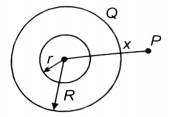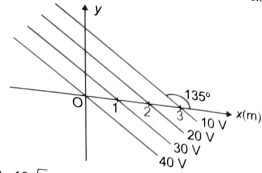When a test charge is brought in from infinity along the perpendicular bisector of an electric dipole, the work done is:
1. Positive
2. Zero
3. Negative
4. None of these
The electric potential at a distance of 3 m on the axis of a short dipole of dipole moment coulomb-metre is:
1.
2. 4 mV
3. 12 mV
4. 27 mV
The electric potential in volts due to an electric dipole moment of coulomb-metre at a distance of 3m on a line making an angle of with the axis of the dipole is:
1. Zero
2. 10 V
3. 20 V
4. 40 V
An electric dipole of length 2 cm is placed with its axis making an angle of to a uniform electric field . If it experiences a torque of , then the potential energy of the dipole:
1. -10 J
2. -20 J
3. -30 J
4. -40 J
A hollow charged metal sphere has radius r. If the potential difference between its surface and a point at a distance 3r from the centre is V, then the electric field intensity at distance 3r from the centre is:
1.
2.
3.
4.
Two concentric hollow conducting spheres of radius r and R are shown. The charge on the outer shell is Q. What charge should be given to the inner sphere so that the potential at any point P outside the outer sphere is zero?

1.
2.
3.
4.
The potential gradient is a:
1. vector quantity.
2. scalar quantity.
3. conversion factor.
4. constant.
The electric potential V at a point P(x, y, z) in space is given by volt. The electric field at a point (1m, 0, 2m) in V/m is:
1. 8 along the -ve x-axis
2. 8 along the +ve x-axis
3. 16 along the -ve x-axis
4. 16 along the +ve x-axis
The figure shows the variation of electric field intensity E with distance x. What is the potential difference between two points at x=2 m and at x=6 m from O?
1. 30 V
2. 60 V
3. 40 V
4. 80 V
The figure shows a set of equipotential surfaces. The magnitude and direction of the electric field that exists in the region are:

1. V/m at with x-axis
2. V/m at with x-axis
3. V/m at with x-axis
4. V/m at with x-axis







